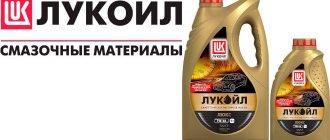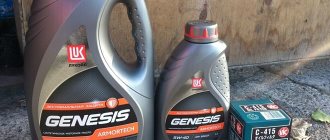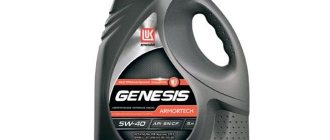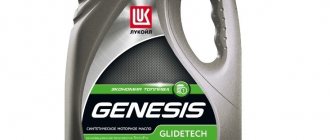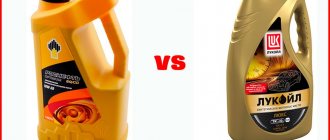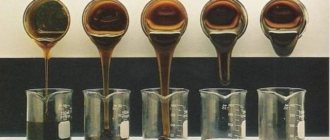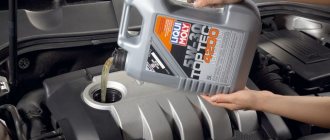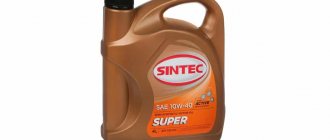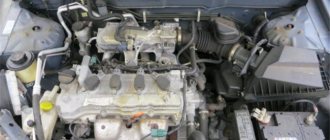Lukoil Lux 5W-30 is a high quality synthetic motor oil comparable to foreign analogues in many respects. Manufactured using a technological base dominated by balanced additives that meet the latest standards in the field of environmental friendliness and efficiency. The original Lukoil product has stable viscosity and washing characteristics - largely due to a durable oil film, which ensures the safety of parts, protecting them from premature wear, dry friction and overheating throughout the entire service period - until the next oil change. The film not only helps reduce friction, but allows parts to interact more smoothly with each other. Thus, the resource and potential of the engine significantly increases.
Lukoil oil maintains optimal oil pressure in warm weather and also has stable viscosity at low temperatures. Thanks to the universal all-season characteristics, the oil is quickly pumped and immediately supplied to the parts. In addition, the manufacturer claims an extended replacement interval, which allows saving on consumables.
The most popular articles on the site:
- How often should you change engine oil?
- Oil 5w30 and 5w40 what is the difference
- What oil to pour into the engine in winter and summer
- How long does it take to change the automatic transmission oil?
The best motor oil. does it exist?
The presence of a balanced package of lubricating additives provides effective dispersing and solubilizing properties, thanks to which filters and valves are never clogged with soot. The fact is that all sludge compounds, soot and chlorine are retained and dissolved in the motor oil, which does not thicken and retains its viscosity characteristics. Based on this, it is possible to guarantee the preservation of the factory oil parameters at low or high temperatures, during quiet or intense driving modes, in rainy and slushy weather, at maximum power and speed, as well as in urban conditions with frequent starts and stops in traffic light traffic jams.
Purpose
Lukoil Lux 5W-30 is used in modern highly accelerated engines - both gasoline and diesel, naturally aspirated and turbocharged engines. Compatibility is declared with catalytic systems or particulate filters that are installed in gasoline and diesel internal combustion engines (respectively) to improve environmental friendliness. Russian oil is poured into cars, minibuses and trucks of domestic and foreign production, which have the appropriate approvals and specifications.
Despite having all kinds of approvals from the largest brands, Lukoil oil was originally made for Ford cars. This lubricant is also widely used in Renault and AvtoVAZ cars. The Lukoil product is designed for use in urban and off-road conditions, with high overloads (maximum speed, towing heavy trailers).
Oil marked 5W-30 has a synthetic base and all-season characteristics, i.e., it is suitable for most climate ranges. It is used all year round - both summer and winter. In particular, compatibility is declared with cold temperatures down to minus 35 degrees (5W value), as well as hot temperatures up to plus 40 degrees.
Application area Lukoil Luxe Synthetic SN CF SAE 5W 40
The development was carried out in close cooperation with a number of leading passenger car manufacturers. Therefore, the oil is intended primarily for small class vehicles.
The composition can be used on minibuses and light trucks:
- naturally aspirated gasoline engines with a high degree of boost;
- petrol turbocharged engines with high liter power;
- diesel engines (aspirated and turbocharged), with the exception of soot filtration systems (DPF).
The oil is successfully used in taxi fleets where the vehicles are operated in busy urban conditions. In addition, Lux 5W40 SL CF can be filled into passenger cars of courier delivery services.
Classification
SAE is an international standard of the US Association of Automotive Engineers, presented in three categories depending on the season:
- Winter - marked with the letter W (Winter) and contains six viscosity levels: from 0W to 25W
- Summer - its marking contains only the viscosity number (without a letter). There are five viscosity levels in total - from 20 to 60.
- All-season - marked with Russian GOST or an international double symbol, for example, SAE 15W-30.
API is another American standard (US Petroleum Institute), which includes two large categories:
- Service (S) – recommended for passenger cars and commercial vehicles with four-stroke gasoline engines. There are ten classes in this category, the most technologically advanced of which is SL class fluid for gasoline multi-valve turbocharged internal combustion engines. The principle for designating each class is as follows: the closer the letter is to the end of the alphabet, the higher the requirements for oil.
- Commercial (C) – suitable for commercial trucks, agricultural vehicles and road construction equipment with diesel engines. This category contains eleven classes labeled in the form of a Latin letter. The higher the oil requirements, the closer the letter is to the end of the alphabet. The most advanced oil in this case is CI-4 fluid for high-speed diesel engines.
Universal oils according to API are double marked with a fraction - for example, SG/CD. The canister may display an API mark, but to fully ensure that the oil complies with this standard, a valid certificate is required.
ILSAC is an international standard for Japan and the USA, developed by the Automobile Manufacturers Association of both countries. Includes five GF classes.
- GF-1 – considered obsolete. Corresponds to API SH class, designed for viscosity classes 0W-XX, 5W-XX and 10W-XX, where instead of XX there should be a value from 30 to 60.
- GF-2 – has been in operation since 1996, complies with API SJ class and has SAE viscosity classes 0W-20 and 5W-20 (in addition to GF-1)
- GF-3 - entered into force in 2001, designed for API SL classification. Has the best anti-wear and anti-oxidation characteristics. Evaporates less and has energy-saving characteristics. Otherwise, it is similar to the API SL and ILSAC CF-3 classes.
- GF-4 – has been in force since 2004, corresponds to API SM classification. It has pronounced energy-saving characteristics, as well as viscosity classes 10W-30, 5W-30, 0W-20, 5W-20 and 0W-30. Compared to GF-3, it has better antioxidant properties and is endowed with cleaning properties. It has less tendency to form deposits. Also declared compatibility with systems for reducing exhaust gas toxicity (catalytic converters for gasoline engines)
- GF-5 - entered into force in 2010, complies with the API SM class and has strict fuel efficiency requirements. Compatibility with catalytic systems and elastomers is declared. GF-5 is resistant to deposit formation in turbocharged and naturally aspirated engines, has cleaning properties and evaporates less.
Based on the above, we highlight the key features of ILSAC:
- Improved energy saving capabilities
- Increased anti-wear properties and protection against deposits
- Higher compatibility with catalytic systems to reduce exhaust gas toxicity.
ACEA is a European international standard, very common in world practice. Includes three important categories:
A/B: Suitable for passenger cars and compact trucks (LCV) with gasoline and diesel engines. Based on this fact that this category is the most common, let’s consider it in more detail:
- A1/B1: marking for LCVs and passenger cars with gasoline and diesel engines. This oil has low high-temperature viscosity and energy-saving properties.
- A3/B3: marking for LCVs and passenger cars with more advanced gasoline and diesel engines. This oil has an extended drain interval, low-viscosity parameters and the possibility of year-round use.
- A3/B4: marking for diesel and gasoline engines with direct fuel injection. This oil meets stringent requirements for piston cleanliness.
- A5/B5: marking for passenger and commercial vehicles with gasoline and diesel internal combustion engines. Designed for oils with low viscosity, energy-saving properties and extended drain intervals.
C: recommended for environmentally friendly gasoline and diesel engines.
E: designed for diesel trucks with increased loads.
Next, let's look at the specifications and tolerances for Lukoil Lux 5W-30 motor oil:
- API SL;
- API CF;
- ACEA A5/B5, A1/B1
- Renault RN 0700;
- AvtoVAZ;
- Ford WSS-M2C.
Technical characteristics, tolerances, specifications
| Complies with class | Explanation of the designation |
| API SL/CF; | SN is the quality standard for automobile oils since 2010. These are the latest stringent requirements; oils certified according to the SN standard can be used in all modern generation gasoline engines manufactured in 2010. CF is a quality standard for diesel engines, introduced in 1994. Oils for off-road vehicles, engines with split injection, including those running on fuel with a sulfur content of 0.5% by weight and higher. Replaces CD oils. |
| ACEA A5/B5, A1/B1; | ACEA oil classification. Until 2004 there were 2 classes. A – for petrol, B – for diesel. Then they were combined A1/B1, A3/B3, A3/B4 and A5/B5. The higher the ACEA category number, the more stringent the requirements the oil meets. |
Laboratory tests
| Index | Value/Unit |
| Density at 15°C | 850 kg/m3 |
| Kinematic viscosity at 100°С | 10.2 mm2/s |
| Viscosity index | 173 |
| Dynamic viscosity CCS at -30°C | 4,024 mPa*s |
| Dynamic viscosity MRV at -35°C | 20 100 mPa*s |
| Base number | 10.2 mg KOH/g |
| Sulfated ash content | 1,0% |
| Evaporation according to the Noack method | 11% |
| Flash point in open crucible | 222°C |
| Pour point | -40°С |
| ACEA approval | A5/B5, A1/B1 |
| API clearance | SL/CF |
| Dynamic viscosity at -25℃ | — |
| Acid number | 2.30 |
| Sulfur content | 0,265 |
| Fourier IR Spectrum | VHVI (equal to synthetics) |
| NOACK | 11,3% |
Approvals Lukoil Lux 5W-30
Endorsements
- API SL – licensed (Energy Conserving)
- Renault RN 0700
- JSC AVTOVAZ
Meets requirements
- API CF
- ACEA A5/B5, A1/B1
- Ford WSS-M2C913-A, WSS-M2C913-B, WSSM2C913-C
Release form and articles
- 196272 – Lukoil Lux Synthetic 5W-30 – 1L
- 196256 – Lukoil Lux Synthetic 5W-30 – 4L
- 196674 – Lukoil Lux Synthetic 5W-30 – 18L
Advantages
- Maximum engine protection in difficult conditions.
- Fuel saving.
- Reduced engine noise.
- No harm to the catalytic afterburner.
- Elimination of deposit formation on nodes.
- Approved by leading automakers.
- Acceptable price.
Flaws
- Not detected
How to determine the original from a fake
- Fake oil costs 10-20% less than the original product. “Cheap” oil can be found in small stores or from resellers on the Internet, who do not have any responsibility, and therefore can make even the injured buyer to blame. In large stores, a fake can cost the same as the original product - thus, scammers try not to arouse suspicion. And yet, it is not profitable for them to sell such oil, since in a large store all responsibility falls on the unscrupulous seller.
- The original packaging with oil is made of high-quality plastic, which has inclusions and can shimmer in the light, like metallic paint on cars. The surface of such a canister is smooth, with smooth edges and without any defects (sinks, burrs, etc.). Let us also pay attention to the markings of the oil level scale, which on the fake are uneven, or even have colored marks instead of casting. In addition, the “makeshift” canister has non-uniform and translucent plastic, through which you can see where the two halves of the container are welded together.
- The original label is applied to the canister evenly and without any bubbles. It is not so easy to pry off such a sticker with your fingernail. The label contains information about the product in a clear, uniform font with no spelling errors. Let us also pay attention to the quality of printing. For example, a fake's images look faded and blurry. In addition, they do not have gradients or color transitions.
- The date of manufacture of the canister (it can be found at the bottom of the container) should be earlier than the date of manufacture of the motor oil. The date stamp appears clearly and without wear. Only the original canister has information about the batch number and expiration date.
Below, readers are presented with cover protection options:
- A retaining ring-seal with antennae that secure the lid from accidental opening. Instead of a ring, it is more profitable (cheaper) for scammers to use ordinary glue, due to which oil can leak out of the canister - for example, if it is turned upside down. In addition, the unscrupulous manufacturer refuses to engrave the brand, and also makes the relief of the lid ribs narrower than the original.
- A barcode or manufacturer's logo located on the side of the retaining ring. In addition, the inscription with the logo also appears on the lid, so that after opening the lid, the logo is divided into two halves. Restoring such an inscription in makeshift conditions is not so easy.
- Hologram with Original or Genuine symbols, which can be seen at an angle. It shimmers in the light and has the property of self-destructing, that is, the symbols disappear after opening the lid.
How to distinguish a fake?
Lukoil 5w30 engine oil performs well in real conditions, with different types of engines and fuel. But this lubricant is not often counterfeited, since it is not beneficial for attackers. Lukoil has nevertheless provided protection against fraudsters. They mainly concern packaging with contents.
Multi-component cover. It is made from a combination of plastic polymer and red elastane. The lid includes a ring that comes off the product, and a special aluminum foil is placed inside it.
Three-layer canister. When you open the package, you will find that the container consists of several layers of plastic. This is all done on special complex equipment made from multi-component elements. It is impossible to counterfeit packaging using homemade equipment.
Special label. The label on the Lukoil oil canister is not glued in the standard way, but is fused into the container at the production stage and forms a one-component product with the canister. This technology eliminates the possibility of counterfeiting goods. The label is not afraid of moisture and sun rays, so the presentation of the product is preserved longer than when applying an information label using the standard method.
Personal index code. The serial number of the product is printed on the back of the package. This is necessary for logistics, that is, tracking a specific canister from a batch.
Signs of low-quality (fake) oil during operation:
- Problems starting the engine in cold weather. They occur due to oil freezing, which causes parts to experience dry friction, overheating, excessive wear and insufficient lubrication. Ultimately, internal combustion engine components can melt under the influence of critical temperatures.
- Excessive oil consumption and the need to top up. Such problems arise for well-founded reasons: firstly, the fake oil does not meet the parameters indicated on the label. Secondly, the counterfeit substance has increased carbon dioxide, volatility and volatility, and is also prone to the formation of deposits. Dirt from wear accumulates in the oil passages until the engine fails and requires major overhaul.
Advantages:
- Dispersing and solubilizing properties contribute to the formation of a durable oil film, as well as maximum protection of filters and valves from sludge and soot deposits.
- Possibility of starting in cold temperatures, as well as effective pumping of oil during the first start, or after a long period of standing in the garage
- Low carbon dioxide and low volatility, as well as minimal volatility and lack of foam in cold and hot states
- Stable viscosity indicators, resistance to thermo-oxidative and thermal processes under the influence of increased loads
- No dry friction between parts due to oil film
- Compatible with sealing materials for engines of various automakers, primarily Ford, AvtoVAZ and Renault
- Effective anti-corrosion protection and no harm to metal parts
- Compatible with high purity systems (catalytic converters and particulate filters)
- Low noise level, increased efficiency, power and torque of the engine.
Reviews
- Gennady, Nizhny Novgorod region. I have a purely positive review of the oil of the domestic brand Lukoil. For me, the fact that this is a full-fledged synthetic, not inferior to foreign analogues, is enough. I was convinced of this not only in theory, but also in practice. I’ve been convinced for three years now that it doesn’t matter that the oil has risen in price (competitors have also increased their prices). All the same, Lukoil is cheaper and almost in no way inferior. Lukoil 5W-30 Lux is an all-season oil, resistant to temperatures from minus 35 to plus 30 degrees Celsius. At minus 25, the Lada Kalina engine starts with half a turn. And all this is thanks to high-quality oil. I only take a 5-liter canister. I am sure that I will never come across a fake, since I buy from a trusted seller at a dealership. Naturally, oil thickens a little in winter, especially at extremely low temperatures. But everything is within normal limits, the engine starts without problems. At the same time, impressions of the reliability of the car itself have improved. Previously, I filled Lukoil with semi-synthetics - the impressions were much worse. I hope the engine recovers without major repairs, fortunately the odometer is already under 150 thousand km.
- Konstantin, Lipetsk region. After purchasing this oil and using it for a long time, I had doubts about the profitability of purchasing imported lubricants such as Mobile, Castrol, etc. Lukoil Lux 5W-30 is an oil on a 100 percent synthetic base, with a pour point no worse than that of foreign analogues. It has stable viscosity and detergent parameters, does not thicken and does not freeze in frosty weather - at least in my case (I have a 2003 Mazda 6), the replacement period reaches 10 thousand km. My friends with Shell oil have about the same regulations, and in some situations less (still depends on the load and type of engine). Fuel consumption is low - both in the city and on the highway. The carbon emissions are minimal, the amount of sediment is not critical, although the car is quite old, and anything can happen to it. But the oil maintains the endurance of my “six”. Let it always be like this.
- Igor, Yaroslavl. Everyone praises this oil so much that they forget about its shortcomings. There have been a lot of fakes of Lukoil Lux 5W-30 lately, and it also behaves differently in car engines of certain brands - that is, depending on your luck. Of course, the big advantage is the low price compared to foreign analogues. However, Lukoil also “knows how” to rise in price, just like its competitors. When operating a car with oil in this price category, it is necessary to check its level and color. Anything that needs to be changed immediately, otherwise there will be a great loss. The quality of the lubricant leaves much to be desired, and I’m not saying this lightly, but judging by the 3-year operation of Renault Megane 2005 with Lukoil Lux 5W-30 oil. I drove this used car from 2014 to 2021. That is, for the last year of operation I drove with a different oil (Castrol 5W-30). Increased carbon dioxide and a short replacement interval, volatility and evaporation, high fuel consumption and the need for topping up - and these are not all the disadvantages of Lukoil oil.
- Georgy, Novosibirsk. Not a bad oil. But of course, Lukoil alone will not be enough for full-fledged “import substitution”. But seriously, Lukoil Lux 5W-30 is a high-quality synthetic oil that is much cheaper than its Western counterparts and is almost as good as them in performance - well, except in the replacement interval (it’s a little shorter). I chose Lukoil at the height of the so-called Cold War and the 2015 crisis, when all Russian motorists probably switched to a cheaper domestic product. In general, I was right. I drive a 2007 Mitsubishi Lancer with a current mileage of 70 thousand km. The car is cool, including thanks to Lukoil oil, which fully reveals the potential of the not very powerful 1.3-liter engine. I change the fluid every 10 thousand km.
View oil prices
Reviews of Lukoil Lux 5W40 synthetic oil
To obtain operational information about manufactured products, the concern maintains feedback from buyers and wholesale clients.
The questions: “Which is better, Lukoil or Lukoil Lux?” are resolved at the level of engineering and technical staff. To check the quality of the oil, focus groups and joint resource tests are organized together with car plant engineers.
In addition, there are specialized forums in which Lukoil representatives take part:
- users note good cleaning properties, at the same time, the oil has to be changed more often when used in engines with high mileage;
- when switching to Lux 5W40 oil from imported analogues, there was no significant difference in the quality of engine operation;
- The engine noise decreases slightly after warming up.
Engine condition after Lukoil Luxe Synthetic 5W-40 oil - video
